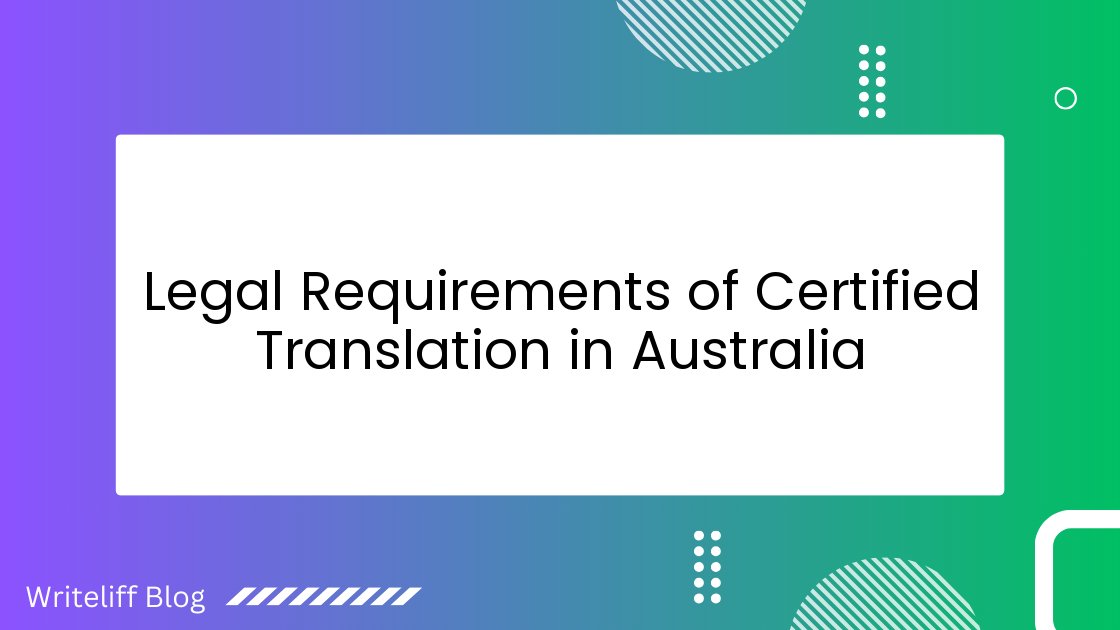Legal Requirements of Certified Translation in Australia

When you’re dealing with official documents in Australia, you might need to get them translated. But not just any translation will do. The Australian government and many organizations require certified translations for important paperwork. This article will guide you through the legal requirements of certified translation in Australia, helping you understand what you need and how to get it done right.
What is Certified Translation?
Certified translation is more than just changing words from one language to another. It’s an official process where a qualified translator confirms that the translation is accurate and complete. In Australia, certified translations are often needed for:
- Visa applications
- Marriage certificates
- Birth certificates
- Academic transcripts
- Legal documents
These translations come with a signed statement from the translator, saying that the translation is true and correct.
Who Can Provide Certified Translations in Australia?
In Australia, certified translations must be done by translators accredited by the National Accreditation Authority for Translators and Interpreters (NAATI). NAATI is the main body that sets standards for translators and interpreters in Australia.
To become a NAATI-certified translator, a person must:
- Pass NAATI’s certification tests
- Have strong language skills in both English and the other language
- Understand translation ethics and practices
- Keep their skills up to date
Only translations done by NAATI-certified translators are accepted as certified translations in Australia.
Legal Requirements for Certified Translations
When you get a certified translation in Australia, it needs to meet certain legal requirements:
- NAATI Certification: The translator must be NAATI-certified for the specific language pair.
- Completeness: The entire document must be translated, including all stamps, seals, and signatures.
- Accuracy: The translation must be a true and accurate representation of the original document.
- Certification Statement: The translator must include a signed statement confirming the translation’s accuracy.
- Translator Details: The translator’s name, NAATI number, and contact information must be provided.
The Certification Process
Here’s what happens when you get a document certified translated:
- You submit your original document to a certified translator or translation service.
- The translator carefully translates the entire document.
- They add a certification statement at the end of the translation.
- The translator signs and dates the statement.
- They include their NAATI credentials and contact information.
- You receive the certified translation along with the original document.
Common Documents Requiring Certified Translation
Many types of documents often need certified translation in Australia. Here are some common ones:
- Personal Documents: Birth certificates, marriage certificates, divorce papers
- Educational Documents: Diplomas, transcripts, course descriptions
- Legal Documents: Contracts, court documents, powers of attorney
- Business Documents: Company registration, financial statements
- Immigration Documents: Passports, visas, police clearance certificates
Costs and Timeframes
The cost of certified translation in Australia can vary depending on several factors:
- The length of the document
- The complexity of the content
- The language pair (some languages are rarer and more expensive)
- How quickly you need the translation
Typically, prices start from around $60-$80 for a single-page document. More complex or longer documents will cost more. Rush services are usually available but come at a higher price.
Timeframes can range from 1-3 business days for standard service to same-day or next-day for urgent requests.
Online vs. In-Person Services
You can get certified translations both online and in person. Each has its pros and cons:
| Online Services | In-Person Services |
|---|---|
|
|
Both options are valid as long as the translator is NAATI-certified and follows all the legal requirements.
Key Takeaways
- Certified translations in Australia must be done by NAATI-accredited translators.
- The translation must be complete, accurate, and include a signed certification statement.
- Common documents needing certified translation include personal, educational, legal, and immigration papers.
- Costs and timeframes vary based on document length, complexity, and urgency.
- Both online and in-person services are available for certified translations.
How Writeliff Can Help
If you’re looking for reliable certified translation services, Writeliff is here to help. We work with NAATI-certified translators to provide accurate and legally compliant translations for all your needs. Whether you’re applying for a visa, enrolling in an Australian university, or handling legal matters, we’ve got you covered. Don’t let language barriers hold you back – check out our certified translation service today!
Final Thoughts
Navigating the world of certified translations in Australia might seem tricky at first, but it’s really about following a set of clear rules. By understanding what’s required and working with qualified professionals, you can ensure your documents are properly translated and accepted by Australian authorities. Remember, when it comes to important paperwork, it’s always better to do things right the first time. If you’re ever unsure, don’t hesitate to ask for help from certified translation services.